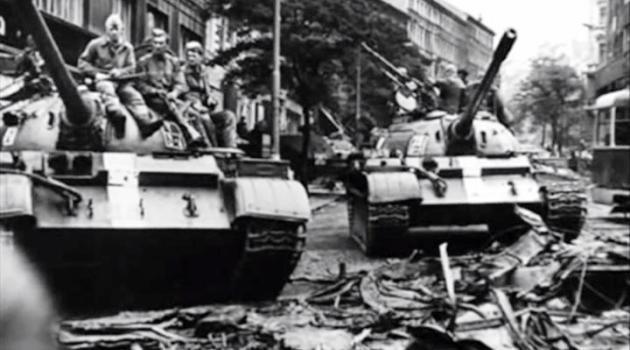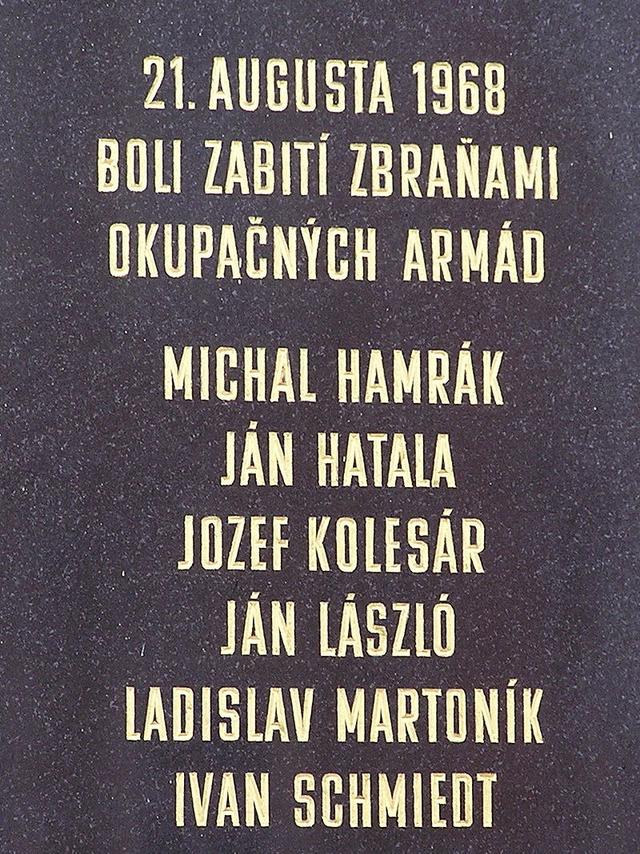Memories of the 1968 invasion of Czechoslovakia: Young Romani resister killed by the Warsaw Pact occupiers still not named on memorial

Last month both the Czech Republic and the Republic of Slovakia commemorated the 54th anniversary of the occupation of Czechoslovakia by troops from Warsaw Pact countries led by the Soviet army during the night of 20 August and early morning hours of 21 August 1968, during which dozens of inhabitants of Czechoslovakia died in clashes with soldiers or in traffic accidents caused by the occupiers. In Košice, Slovakia, one of the resisters who was shot to death by the invaders was a Romani man, Bartolomej Horváth.
One of the occupiers’ victims was Romani
The invasion of Czechoslovakia by the Warsaw Pact troops on 21 August 1968 cost the lives of more than 130 victims – in Košice alone, six people were shot dead, including a Romani man, Bartolomej Horváth, during the first day of the occupation. He lived at Dobrianského 13.
Mr. Horváth was a construction worker and was single. At the time of the invasion, he was working on the construction of the Hotel Slovan on Náměstí osvoboditelů (Liberators’ Square) in Košice.
When the occupiers drove through the town at about 11 AM on 21 August, Mr. Horváth ran out from the construction site and crawled onto one of the tanks. He used a shovel to try and break the glass of its periscope.
A soldier then came out of the tank and fired a machine gun at him. The young Romani man suffered gunshots to his abdomen and a projectile also damaged his left arm.
He was taken to the hospital in Rostislavova Street, where he fought for his life for another two weeks. He succumbed to his injuries on 11 September 1968.
Mr. Horváth is buried in the cemetery in Košice 1. However, while the victims of the occupation have been commemorated in a memorial plaque in Košice, his name is not listed among them.
“Bartolomej Horváth was not listed among the victims because he was a Romani man. He was the biggest hero, though, he crawled up on that tank and broke its periscope with his shovel,” Peter Neuwirth told news server iRozhlas.cz previously.
“Bartolomej Horváth was a brave young man who did not hesitate to defend our country during the occupation. His courage was fateful and he died at the age of 21,” those who organize the Roma Spirit award in Slovakia previously announced.
“Despite that fact, his name is missing to this day on the memorial plaque to the victims,” the Roma Spirit organizers related. Mr. Horváth was given the Roma Spirit award in 2018 in memoriam for his demonstrated bravery during his direct clash with the troops, during which he suffered the injuries to which he later succumbed.
Other Roma also stood up to the occupation
Bartolomej Horváth was not the only Romani man who disagreed with the occupation – other Roma also stood up to it, a fact that fundamentally influenced their fates. “The moment they invaded, I knew it would not be good. I said to myself that the people would probably be against it, though. They were, but then they all became afraid and stayed quiet. I couldn’t, it reminded me of when we were under the Germans. I told myself: If they get rid of Dubček, I will take action. They did, and I quit. I was a building management technician, they fired me for disagreeing with the invasion,” Romani community member Zdeněk Daniel recalled for the Memory of the Roma (Paměť Romů) video series.
” ‘You cannot think this is a normal situation with which I, as a Czechoslovak citizen and Czechoslovak Army officer, can agree’. I just said: ‘No, this is crude aggression and you know it as well as I do’. Then I was out of there,” Romani community member Karel Holomek described the repercussions of his criticizing the invasion for the Memory of the Nation (Paměť Národa) media series.
VIDEO
Romanes-language audio recording from 1968
During the beginning of the occupation, state radio played a significant role by broadcasting up-to-date information. The relay broadcasts of Czechoslovak Radio in August 1968 have gone down in history.
Announcers and technicians broadcast from different hidden locations all over Czechoslovakia. However, their calls, reports and resolutions were not just read in Czech.
The editors knew that journalists abroad were listening to their broadcasts, as were the members of different linguistic minorities. A protest against the occupation was also broadcast in English and Russian, therefore.
A broadcast in Romanes was recorded on 25 August 1968 by Milena Hübschmannová. “Dear friends, here in our country, in our republic, live more than a quarter million of our fellow citizens who are Gypsies [Cikáni]. At this moment it is necessary that each and every citizen of our occupied republic gets a good grasp of the situation. For that reason we will now turn to our fellow-citizens of Gypsy [Cikánská] nationality in their mother tongue,” her recording begins.
The broadcast in Romanes then begins: “Phralale Romale amen sam trin šel ezera Roma, so dživas andre amaro štatos, andre Československo socialisticko republika. Amen Roma varekena phenas Rom Romeha gadžo gadžeha, bo hin ajse gadže, so na den le romenge paťiv, aľe the maškar amende hin ajse manuša, so maťon maren peskere Romenge ladž, nane oda čačipen? Aľe akana hin ajsi situacija, že amen imar našťi phenas Rom Romeha, gadžo gadžeha….” – “Romani brothers, there are 300,000 of us living in our state, the Czechoslovak Socialist Republic. We Roma sometimes say: ‘The Roma with the Roma, the gadje [non-Roma] with the gadje‘ because there are gadje who do not consider us equal to them. There are also Romani people among us who shame us as well, though, isn’t that true? However, now the situation is such that we cannot say ‘The Roma with the Roma, the gadje with the gadje…” (Here the excerpt of the recording unfortunately ends.)
AUDIO
The troops from the five states of the Warsaw Pact occupied Czechoslovakia in 1968 to suppress, through violence, an attempt by the Communist Party’s liberal wing to reform the system. In 1968, throughout all of Czechoslovakia, 58 people were either killed or mortally wounded on the first day of the occupation, and by the close of 1968 the number of victims grew to 108.
The regime’s harsh suppression of demonstrations against the occupation in 1969 cost even more victims. That fact confirmed the incoming era of what was called “normalization“, which involved political purges, the restriction of freedoms, and the strengthening of censorship.
